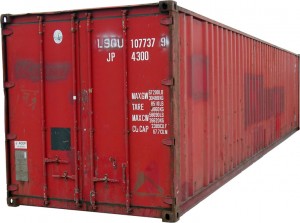 Deciding that I should direct my thoughts to more positive substance than has perhaps been the case over the past few weeks I have begun again to contemplate the complexities of moving our existence to a different continent.
Deciding that I should direct my thoughts to more positive substance than has perhaps been the case over the past few weeks I have begun again to contemplate the complexities of moving our existence to a different continent.
When the Kickass Canada Girl arrived on these shores a little more than a decade ago she did so accompanied by nothing more than a couple of suitcases and thirteen cardboard boxes containing her personal effects. When she returns to BC, with the Immigrant in tow, at some point in the next year she will undoubtedly be closely (hopefully!) followed by a shipping container of some as yet indeterminate size. I rather hope that she will consider this to be a good result for all her endeavours here!
The shipping container – or Intermodal Freight Container as it is perhaps more properly known – is a wonderful thing. Based on designs that evolved during the 1960s and were codified in ISO standards at the turn of that decade, the intention was – of course – to provide a consistent and reliable means of transporting goods throughout the world without the need to unload and reload cargoes.
Constructed from corrugated weathering steel (developed to eliminate the need for painting and forming a stable rust-like patina after extended exposure to weather) the standard container is 8ft high by 8ft wide and comes in nominal 20ft or 40 ft lengths. They are designed to be stacked up to 7 containers high and the corners consist of castings with openings for twistlock fasteners by which means they can be fixed together. The containers are – when new and appropriately certified – both wind and water-tight.
There are – it is thought – now something in excess of 17 million shipping containers in the world!
It is a testament both to the enduring efficacy of a classic design and to human inventiveness that the humble shipping container – designed but with a single purpose in mind – has proved to be a fantastically flexible and useful resource. Aside from the obvious uses – for the actual shipment or storage of goods – I have personally seen containers used for the following:
- as a cricket club sitesafe – for the storage of mowers, rollers and other groundwork equipment.
- as an office. Our dear friends in Saanichton have converted a 40ft container into the site office at their smallholding.
- as a ‘green screen’. Pinewood Studios constructs enormous exterior ‘green screens’ using walls of shipping containers.
Indeed – shipping container architecture has evolved into quite a field in its own right – as can be seen from this Wikipedia article.
I had not – needless to say – actually intended to post here a general piece on the admirable container, thinking rather that I would go into some detail regarding the complexities of using such to facilitate our emigration.
A second post is clearly called for…


Recent Comments